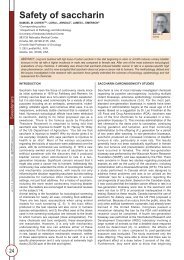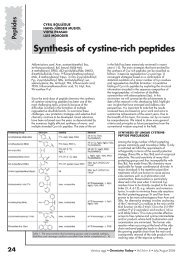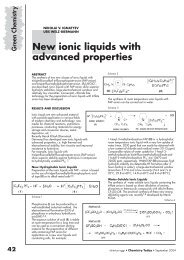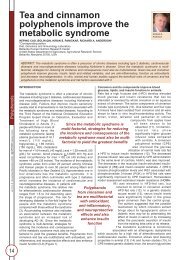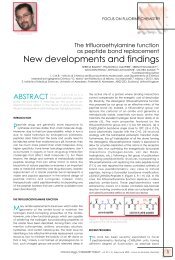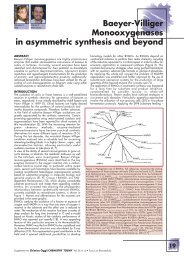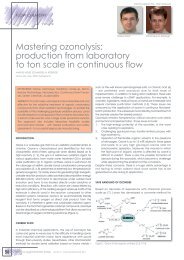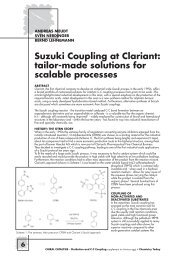Pietro Delogu [modalità compatibilità]
Pietro Delogu [modalità compatibilità]
Pietro Delogu [modalità compatibilità]
Create successful ePaper yourself
Turn your PDF publications into a flip-book with our unique Google optimized e-Paper software.
CONTINUOUS FLOW PROCESSES<br />
A MULTIPRODUCT MODULAR<br />
APPROACH<br />
<strong>Pietro</strong> <strong>Delogu</strong><br />
P.Le Marinotti 1, 33050 Torviscosa (UD)
Mappa<br />
Where Serichim is
Chemistry<br />
Technology<br />
Regulations<br />
What Serichim does<br />
New solutions for<br />
our customers<br />
“One Customer” Processes<br />
Multiclient technologies:<br />
continuous flow processes
“CONTINUOUS FLOW PROCESS “<br />
Why it is important<br />
• A “new” tool for European Chemical Industry<br />
to maintain its competitivity<br />
• An emerging technology with big impact on<br />
the Fine Chemicals, Advanced Intermediates<br />
and Pharmaceutical Active Ingredients<br />
manufacturing
(reduced) Standard list of advantages usually claimed<br />
in the literature for “flow chemistry”<br />
Easy scale up<br />
Low<br />
environmental<br />
impact<br />
Safety<br />
Process<br />
intensification<br />
Reliability
Our experience on “process intensification”<br />
advantage: the Project Output<br />
API Productivity improvement<br />
obtained for the main<br />
reaction<br />
(Continuous/Batch)<br />
Monthly required<br />
capacity<br />
Kg/month<br />
Main reactor<br />
volume<br />
litres<br />
Neuroleptic 40 a) 50000 200<br />
Antiviral 90 b) 5800 50<br />
Antidiabetic n.a. 3600 10<br />
a) technology only based<br />
b) chemistry and technology based<br />
π<br />
π<br />
batch<br />
1 ⎡ m ⎤<br />
=<br />
Sτ<br />
⎢Vt<br />
⎥<br />
b ⎣ ⎦<br />
S = dimensional<br />
factor, l (of reactor)/g (of product)<br />
τ =<br />
continuous<br />
batch time,<br />
h<br />
Fc c ⎡vm<br />
m ⎤<br />
= =<br />
⎢<br />
=<br />
V τ ⎣tvv<br />
vt ⎥<br />
⎦<br />
F = overallflowrate,<br />
l/h<br />
c =<br />
V<br />
τ =<br />
=<br />
product concentration,<br />
g (of product)/l (of<br />
reactor volume,<br />
l<br />
residence time, h<br />
solution)
A common synthetic sequence<br />
Solvent A<br />
Quencher/<br />
workup agent<br />
preparation<br />
Raw material<br />
(solid)<br />
Raw material<br />
Dissolution<br />
τ1<br />
Quencher<br />
Reagent/<br />
solvent/<br />
catalyst<br />
Reaction<br />
τ2<br />
Quenching<br />
τ3<br />
Workup<br />
wastes<br />
Co-reagent<br />
Co-reagent<br />
preparation<br />
Solvent B<br />
Antisolvent<br />
Batch<br />
Crystallisation<br />
τ4<br />
Filtration<br />
Drying<br />
Product<br />
Continuous<br />
Mother<br />
liquor<br />
τ = τ + τ + τ +<br />
b<br />
1<br />
τ = τ<br />
2<br />
2<br />
3<br />
( τ 4)
Co-reagent<br />
Plant asset comparison<br />
Batch PFD<br />
Batch<br />
Reactor<br />
Filter<br />
Continuous PFD
Batch<br />
Batch-<br />
Continuous-<br />
Batch<br />
Continuous<br />
Scheduling options<br />
ID Operation<br />
1 Raw material dissolution<br />
2 Co-reagent preparation<br />
3 Reaction<br />
4 Quenching & workup<br />
5 Crystallisation<br />
Lun 12 Set<br />
12 1 2 3 4 5 6 7 8 9 10 11 12 1 2 3 4 5 6 7 8 9 10<br />
Equal productivity<br />
for all equipments
Some conclusions on process<br />
arrangements<br />
• If we look only to the reaction we can get<br />
misleading conclusions.<br />
• Continuous mode has to be used for the<br />
longest operation sequence as possible.<br />
• As a rule, the continuous advantages are<br />
higher when the reaction time is potentially<br />
quite lower than the “service time”.<br />
• Reaction chemistry and process engineering<br />
have to be carried out at the same time!
The neuroleptic case<br />
A + B<br />
water<br />
C + byproducts + 76.5 kcal/mole<br />
Organic Inorganic Organic Inorganic<br />
Half life time: from minutes to tens of minutes<br />
depending on temperature and reagent concentrations<br />
Batch time about 4 hours
Batch process PFD
Raw material<br />
and solvent<br />
Co-reagent<br />
RE-100/A<br />
Continuous process PFD<br />
RE-100/B<br />
PFR reactor 200 l<br />
Quencher 1<br />
CSTR 1<br />
50 l<br />
Quencher 2<br />
Counterextraction<br />
solvent<br />
CSTR 2<br />
50 l<br />
L-L extractor<br />
Aqueous butanol<br />
Waste Treatment<br />
Solvent<br />
vessel<br />
Batch Units<br />
Continuous reactors<br />
Continuous work up equipments<br />
Process vessels<br />
Evaporator<br />
Crude<br />
vessel
Where intensification was obtained<br />
• In the reaction section intensification is a<br />
consequence of better heat exchange of the<br />
continuous reactor;<br />
• In the extraction section the improvement is<br />
due to the outstanding properties of liquidliquid<br />
continuous countercurrent extraction.
Our proposal: a Multiproduct<br />
Functional Unit
Scaling up of continuous reactors:<br />
is it so simple?
Scaling up main parameters<br />
• Batch reaction:<br />
• Continuous reaction:<br />
Batch reactor scaling up for<br />
homogeneous reaction<br />
Pilot scale<br />
• Surface to volume ratio<br />
• Surface to volume ratio<br />
• Retention time distribution<br />
Production scale
Pilot scale<br />
S<br />
V<br />
Tubular reactor scaling up<br />
2<br />
= r = reactor<br />
r<br />
radius<br />
Production scale<br />
Vi<br />
vi = vp<br />
Vp<br />
v = linear velocity<br />
V<br />
=<br />
reactor volume<br />
p = pilot<br />
i = industrial production
Solutions to scale up problems:<br />
numbering up<br />
Really no scaling up!
T1<br />
T2<br />
Solutions to scale up problems:<br />
T3<br />
T4<br />
T5<br />
T6<br />
CSTR cascade<br />
P(θ)= fraction of feed having less than given<br />
residence time<br />
1.0<br />
0.9<br />
0.8<br />
0.7<br />
0.6<br />
0.5<br />
0.4<br />
0.3<br />
0.2<br />
0.1<br />
Retention time integral distribution<br />
for a series of n equal volume CSTRs<br />
Number of CSTR<br />
0.0<br />
0 0.5 1 1.5 2 2.5 3 3.5 4<br />
θ/τ= θ/τ=Residence θ/τ=<br />
time/nominal residence time<br />
1<br />
2<br />
4<br />
6<br />
8<br />
10<br />
12<br />
14<br />
16<br />
18
Examples of RTD distributions of pilot<br />
ηηSiemens<br />
4.0<br />
3.5<br />
3.0<br />
2.5<br />
2.0<br />
1.5<br />
1.0<br />
0.5<br />
0.0<br />
Series of 10 CSTR<br />
η⎠= 48 min, 10 Hz<br />
0.0 0.5 1.0 1.5 2.0 2.5 3.0 3.5<br />
F*t/V react = t/η<br />
reactors<br />
mS<br />
2.0<br />
1.8<br />
1.6<br />
1.4<br />
1.2<br />
1.0<br />
0.8<br />
0.6<br />
0.4<br />
0.2<br />
Tubular reactor<br />
0.0<br />
16.4 8.00 17.0 2.24 17 .16.4 8 1 7.31. 12 17.45 .36 18.0 0.00 18. 14.24 18 .28.4 8<br />
Ti me
We can use different PFRs, but we<br />
have to reproduce or to improve RTD<br />
Reactor discretization as<br />
a bundle of ideal PFRs<br />
μμμ μSiemens<br />
4.0<br />
3.5<br />
3.0<br />
2.5<br />
2.0<br />
1.5<br />
1.0<br />
0.5<br />
E(t)<br />
τ τ τ τ = 48 min, 10 Hz<br />
0.0<br />
0.0 0.5 1.0 1.5 2.0 2.5 3.0 3.5<br />
F*t/Vreact = t/ ττ ττ<br />
θ
Fast evaluation of PFR performance<br />
moles/initial moles<br />
1.2<br />
1<br />
0.8<br />
0.6<br />
0.4<br />
0.2<br />
0<br />
batch experiment<br />
output<br />
reagent clac<br />
Intermediate calc<br />
Product calc<br />
reagent exp<br />
intermediate exp<br />
product exp<br />
0 20 40 60 80 100 120 140<br />
time, min<br />
Reactor<br />
discretisation<br />
2.0<br />
1.8<br />
1.6<br />
1.4<br />
1.2<br />
1.0<br />
0.8<br />
0.6<br />
0.4<br />
0.2<br />
0.0<br />
reactor<br />
modeling<br />
Expected<br />
PFR outlet<br />
composition<br />
mS<br />
PFR RTD<br />
measure<br />
0.00 20.00 40.00 60.00 80.00 100.00 120.00 140.00 160.00 180.00 200.00<br />
Time, min
μS/Δμ Δμ ΔμS<br />
1.1<br />
1<br />
0.9<br />
0.8<br />
0.7<br />
0.6<br />
0.5<br />
0.4<br />
0.3<br />
0.2<br />
0.1<br />
Sensitivity results<br />
10 CSTR cascade<br />
0<br />
0 0.1 0.2 0.3 0.4 0.5 0.6 0.7 0.8 0.9 1 1.1 1.2 1.3 1.4 1.5 1.6 1.7<br />
-0.1<br />
θ<br />
Raw material residual contents<br />
CSTR cascade 0.13%<br />
Static mixer 0.10%<br />
Pure batch 0.07%<br />
μS/Δμ Δμ ΔμS<br />
1.1<br />
1<br />
0.9<br />
0.8<br />
0.7<br />
0.6<br />
0.5<br />
0.4<br />
0.3<br />
0.2<br />
0.1<br />
0<br />
Tubular static mixer<br />
0 0.1 0.2 0.3 0.4 0.5 0.6 0.7 0.8 0.9 1 1.1 1.2 1.3 1.4 1.5 1.6 1.7 1.8 1.9<br />
-0.1<br />
θ
Conclusions<br />
• Plug Flow Reactors are able to operate in conditions<br />
forbidden for batch reactors;<br />
• Scaling up has to observe some fundamental rules;<br />
• Chemical development and reactor engineering can<br />
not be carried out sequentially;<br />
• “Pre-built” units can be of valuable help for a fast<br />
and reliable continuous process development.


![Pietro Delogu [modalità compatibilità]](https://img.yumpu.com/12255149/1/500x640/pietro-delogu-modalita-compatibilita.jpg)
